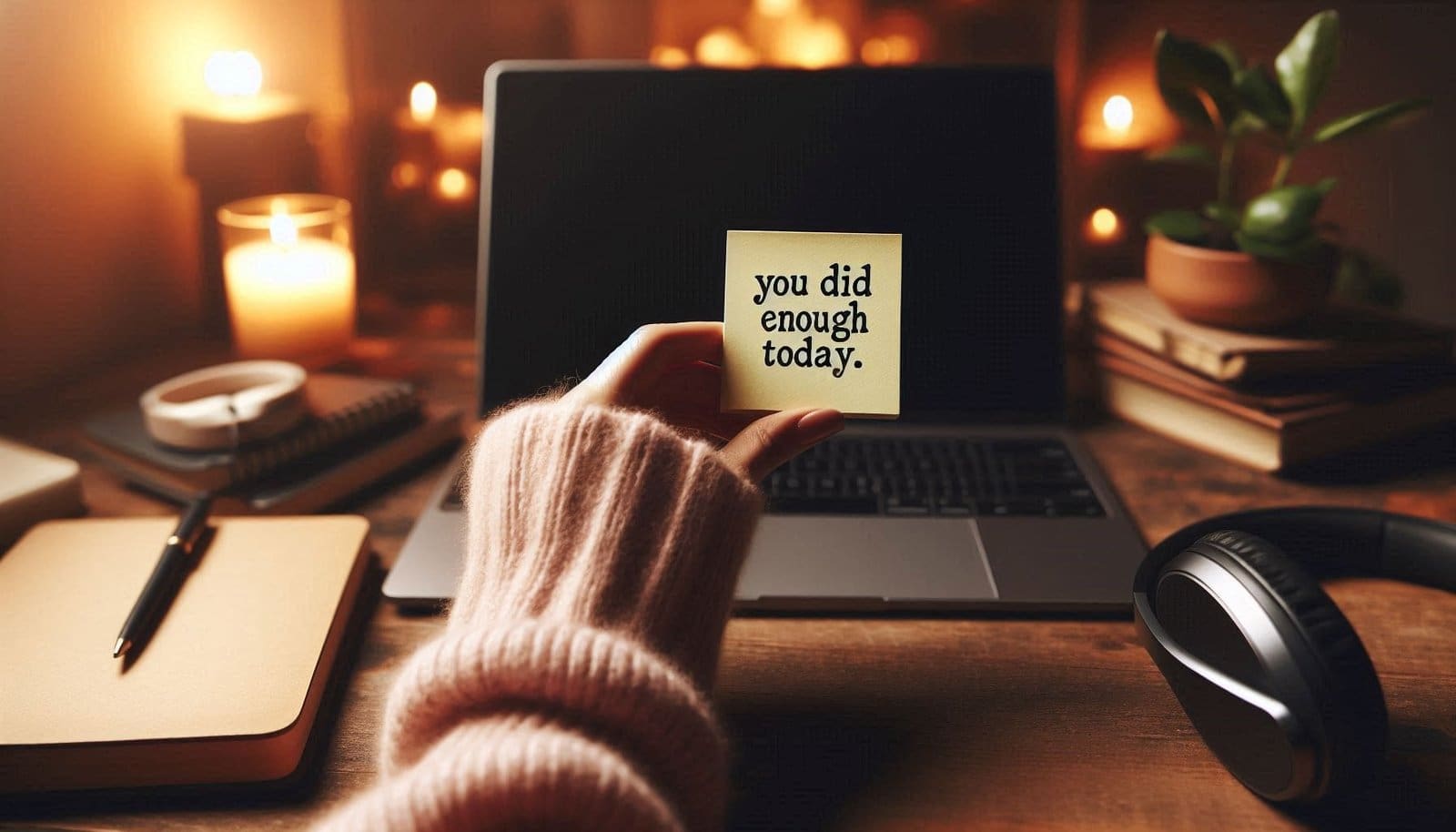Why a Five-Minute Check-In Can Transform Your Creative Life
If you are a solo creator—writing blogs, editing videos, managing clients, planning your own deadlines—you already know how quickly the day can slip through your fingers. Sometimes you look up from your screen and the sun has already set. Your brain feels like it’s always “on”, your messages keep buzzing, and your list of drafts and ideas grows instead of shrinking.
Here’s the hard truth: Solo creators are more prone to burnout than traditional employees.
According to a study published in the International Journal of Environmental Research and Public Health, self-employed workers experience higher emotional exhaustion and stress compared to those in structured environments. And when you work online, the pressure becomes even heavier.
Another research on “techno-stressors” by the National Institutes of Health found that constant digital demands increase anxiety and depressive symptoms when left unmanaged.
This is exactly why a stress check matters.
You do not need a three-hour wellness ritual. What you need is a simple, five-minute nightly pause—a quick, honest look at how you’re showing up emotionally, physically, and creatively. This tiny moment of awareness helps you catch small signals before they grow into burnout, and it lets you reset for the next day with clarity.
In this guide, you’ll learn a reader-friendly, emotionally supportive, research-backed check-in designed specifically for solo creators like you. Think of it as your tiny daily reflection—your anchor in the chaos, your moment to breathe, and your reminder that your well-being matters just as much as your output.
Before we dive into the steps, let’s start with the heart of this system: a five-minute audit that helps you tune in with your entire self.
The Five-Minute End-of-Day Audit

Before we move into the steps, here’s why this routine works: Micro-reflection routines are proven to boost self-awareness, increase emotional clarity, and reduce overwhelm. Even brief moments of reflection support long-term mental well-being.
This quick audit is broken into five one-minute sections, making it easy to do every night without draining your energy.
Let’s walk through each one clearly, with examples and simple explanations.
1. Emotional Pulse: What Feelings Dominated Today
Start your check-in by asking yourself:
- What was my main emotion today?
- Did something drain me or uplift me?
- Did I feel stressed, anxious, excited, neutral, overwhelmed, or peaceful?
This isn’t about psychoanalyzing. The goal is acknowledgment, not judgment.
Naming your feelings helps your brain process them rather than storing them as quiet background noise.
Real-Life Example:
When I was writing Part 1 of my Healing Story Series, I opened emotional wounds while crafting my narrative about Bipolar II and depression. I pushed through it because I wanted the story to be honest and healing for others. By the end of the day, I felt emotionally heavy and drained, but I didn’t immediately recognize it because you kept writing through the exhaustion.
A simple emotional pulse might’ve looked like:
“Today I felt emotionally overloaded because I revisited personal trauma while writing my healing story.”
Why it matters: Research from PubMed Central shows that identifying emotions builds a stronger, clearer sense of self and improves mood regulation.
Quick one-sentence formula:
“Today I mostly felt ___ because ___.”
2. Physical Inventory: Did My Body Ask For Help
Creators often ignore physical cues because creativity feels “mental,” not physical. But your body is always sending signals.
Ask yourself:
- Did I feel tension (neck, shoulders, jaw, back)?
- Did I hydrate or skip meals?
- Did I move or sit for hours without a break?
- Was my sleep enough, or did I drag myself to bed emotionally exhausted?
Real-Life Scenario:
On days when I was juggling SEO blogs, travel pieces, and mental health drafts all at once, I barely got up from your chair. I sometimes wrote for three straight hours without stretching, eating properly, or pausing to breathe—then wondered why my back hurt or my head felt foggy.
This is my physical inventory showing me:
“My body asked for help today and I didn’t listen.”
Why it matters: Ignoring physical cues leads to burnout. The Cleveland Clinic notes that tension, headaches, and body fatigue often appear before full burnout sets in.
Terminology explained:
- Techno-stressors: Stress from constant tech use—notifications, digital multitasking, blurred boundaries.
- Burnout: A state of emotional, physical, and mental exhaustion caused by prolonged stress.
Your body is your creative engine. When it’s overwhelmed, everything else follows.
3. Creative Pressure Gauge: Where Did My Energy Go
This section is about your creative energy, not your task list.
Ask yourself:
- What drained my creativity today?
- What sparked it?
- Did I create from inspiration or obligation?
- Did productivity feel like pressure instead of purpose?
Real-Life Example:
When writing about mental health and recovery, I often deal with heavy topics. This emotional weight can drain my creativity—even if I love the subject. On other days, writing travel blogs or personal reflections reignites my excitement.
There was a week when I was handling travel guides, job applications, and mental-wellness blogs at the same time. I pushed through because I had to deliver, but my creativity felt flat and forced.
This is creative pressure at work.
Why it matters: Self-employed creators often confuse output with worth. Research from the UNH Scholars Repository shows that burnout happens when creators ignore emotional and creative limits for too long.
Reflection pulls you out of autopilot and back into intention.
4. Environment Snapshot: What Surrounded Me Today
Your physical and digital environment directly impacts your mental and creative state.
Ask:
- Was my workspace calm or cluttered?
- Were there too many tabs open?
- Was the lighting harsh?
- Did notifications constantly break my focus?
- Did work and rest blur together?
Real-Life Example:
When I wrote on my laptop in bed during a stressful week, everything blended—work, rest, worry. The room felt heavy, my phone buzzed nonstop, and at night, I felt mentally scattered.
But on days I worked at my desk with natural light and fewer tabs open, I felt lighter and more stable.
Why it matters: According to the University of Exeter, cluttered spaces increase cognitive load, which drains mental energy faster. Restorative environments help the brain recover from fatigue.
Tiny tweaks—light, space, notifications—can completely change your mental wellness.
5. Tomorrow’s Micro Intention: One Small Thing That Supports Me
This step anchors everything.
Micro-intentions are tiny, doable actions that support your well-being the next day.
What you don’t do:
- No long to-do list
- No big life overhaul
- No vague “I’ll stress less tomorrow”
What you do: Choose one small action that supports your mind or body.
Examples:
- Drink water before coffee
- Two-minute breathing before checking messages
- Clear your desk before working
- One must-do task instead of five
- Stretch after every hour of sitting
Real-Life Example:
After an emotionally heavy writing day, my micro-intention might be:
“Tomorrow I will start with a five-minute slow warm-up write instead of jumping straight into deep emotional content.”
Why micro works: Small, consistent habits build long-term mental resilience.
Remember: The biggest change often comes from the smallest consistent step.
Why Solo Creators Need a Daily Stress Check
Before we move into the habit-building section, it’s important to understand why this practice matters so much.
Solo creators take on many roles—creator, strategist, marketer, editor, assistant. Without structure, you carry emotional weight alone.
What often goes unnoticed:
- You finish a full day of tasks, but feel “not enough”.
- You feel tired even when you’re not moving, because mental labor is real labor.
- Your creativity dips, but you keep pushing.
- You disconnected from your work because there were no boundaries today.
These are early stress signals.
Why reflection matters:
Verywell Mind notes that self-reflection shows it improves psychological well-being, supports identity clarity, and reduces distress. And research from MDPI on digital overuse shows burnout mediates techno-stress and emotional difficulty.
A five-minute reflection gives you power back.
How to Turn This Stress Check Into a Daily Habit
Before jumping into my nightly examples, let’s set the foundation:
You now understand the why and the what—let’s talk about how you turn this into a real, lasting habit.
This section helps you integrate the five-minute audit into your actual life, so it doesn’t just become another abandoned routine.
1. Attach it to an existing habit
This removes decision fatigue. Pair it with:
- brushing your teeth
- logging off your laptop
- making tea
- skincare
- prayer or meditation
- journaling time
When it’s linked to something automatic, you won’t forget it.
2. Keep it short
Five minutes is intentional. Anything longer becomes overwhelming.
This routine should reduce stress, not add to it.
3. Use a simple script
Write down your five questions or keep them in a note on your phone:
- Emotion: What did I feel today?
- Body: What did my body say today?
- Creativity: Where did my energy go?
- Environment: What surrounded me?
- Micro-intention: What one small thing will I do tomorrow?
This keeps your check-in focused and fast.
4. Be honest but gentle
Awareness is not self-punishment.
If your check-in shows you were anxious, tired, overwhelmed, or overstimulated—acknowledge it without attacking yourself.
Gentleness builds consistency.
5. Celebrate tiny improvements
Did you drink more water today?
Did you stretch?
Did you pause before reacting?
These small wins matter. They create momentum and resilience.
Real Creators Who Benefit From a Quick Daily Reflection
Here are four real-feeling examples—including your experience—to help readers visualize how impactful this check-in can be.
Leigh, content writer
When I was juggling your Healing Story Series, mental health blogs, travel guides, and job applications, my days became emotionally and mentally heavy. Writing about Bipolar II and depression reopened old feelings, while travel blogs and SEO technical drafts drained my mental focus.
My check-in looked like:
- Emotion: Emotionally heavy after writing a personal narrative.
- Body: Tight back, skipped lunch, shallow breathing.
- Creativity: Inspired but overwhelmed, struggling to switch topics.
- Environment: Laptop in bed, cluttered tabs, late-night writing.
- Micro-intention: “Tomorrow I’ll start with a five-minute free-writing warm-up before diving into emotional content.”
Within a week, I felt lighter, clearer, and more in control of my emotional output.
Mara, freelance illustrator
Mara used to push herself late into the night because she felt every sketch needed to be “perfect”.
In her first check-in:
- Emotion: Anxious because she couldn’t stop looking at client feedback.
- Body: Jaw clenched, shoulders up, laptop on bed.
- Creativity: She felt drained after revising the same illustration again and again.
- Environment: Messy desk, phone notifications pinging.
- Micro-intention: “Tomorrow I will shut my email at 7 PM and sketch for fun for 15 minutes before dinner.”
Within a week, she noticed she was less tense and felt more excited at the start of her personal sketches.
Lea, content writer
Lea often jumped straight into her work without warming up. She noticed her ideas were bland and her writing felt forced.
In her check-in:
- Emotion: Flat/Uninspired because she dove into writing rather than planning.
- Body: Eyes sore, no breaks, coffee heavy.
- Creativity: Felt like “check-box writing” instead of inspired writing.
- Environment: Laptop in living room, overlapping tasks, no distinct “work zone”.
- Micro-intention: “Tomorrow I will write a 5-minute free-write (no editing) before starting actual client work.”
After two days, she found the free-write re-energized her voice and creativity.
Jonas, video editor
Jonas realised he was sitting for long hours, editing foot after foot of footage, and his posture felt awful.
Check-in:
- Emotion: Tired but wired because he sat too long.
- Body: Tight hamstrings, frequent coffee.
- Creativity: He felt like a machine, editing mechanically.
- Environment: One screen, no second break, ventilator noise.
- Micro-intention: “Tomorrow, after each 50-minute edit, I will stand up and stretch for 2 minutes.”
He noticed his back felt looser, and he regained a little more creative spark in his cuts.
These examples show: small awareness creates big shifts. You don’t need massive routines; you need consistent moments of honest check-in.
FAQs
Q1. How long should a mental health check-in take?
It should take around five minutes. The goal isn’t to dig into every detail—it’s to raise your awareness. Five minutes is long enough to anchor you, short enough to actually do daily.
Q2. Do I need a journal or special app for this?
No. You can reflect mentally or type quick notes on your phone. Journaling is optional, not required. The benefit is in reflection, not the tool. Journaling is strongly linked to improved mental health outcomes, but we’re using a lightweight version.
Q3. What if I skip a day?
That’s okay. This practice is meant to be supportive, not punitive. If you skip, just start again the next day. The aim is consistency over time, not perfection.
Q4. I don’t feel stressed—do I still need this?
Yes. The purpose isn’t just to catch huge problems—it’s to prevent them. If you feel fine, then great! Use the check-in to recognise that state and reinforce the positive. Prevention is key.
Q5. When should I do this check-in?
Right at the end of your “work day” or creative session—just before you switch off, shut down, or move on to personal time. That way, you close the day consciously and start your rest time more intentionally.
Your Creative Well-Being Starts With Five Minutes Tonight
As a solo creator, you carry more emotional weight and mental load than most people see. That’s why your mental wellness deserves tools that are simple, sustainable, and kind. A five-minute stress check helps you tune into your emotions, body, creativity, environment, and needs.
It brings clarity.
It prevents burnout.
It protects your passion.
So here’s your invitation:
Set a 9:30 PM reminder tonight.
Give yourself just five minutes.
Do the check-in. Breathe. Notice what comes up.
Then take one final step:
Share one micro-intention in the comments—it might inspire another creator who needs it.
Let the reflection begin, and let your future creative self thank you.





0 Comments